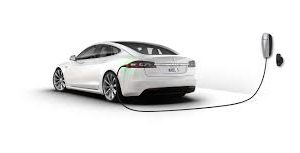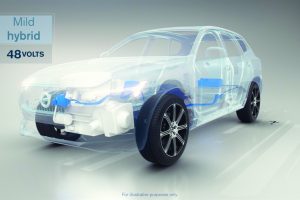When we think of electric cars, it is very often from the perspective of zero emissions or environmentally friendly technology, we also often tend to think in terms of limited range and performance. However, this is becoming less true with each passing year.
The fastest car in the world from 0-60 mph is not an exotic supercar but a 100% electric racing car built by university students, such as the AMZ (Academic Motorsports Club Zurich – comprising students from ETH Zurich and the Lucerne University of Applied Sciences and Arts, pictured above), which achieved a startling time of 1.513 seconds to achieve 60 mph. To put this in perspective the famous Bugatti Veyron can manage the same in around 2.5 seconds. Tesla has changed the perception of the electric car with its high-performance vehicles that are also able to achieve effective ranges of more than 300 miles.
As we can see with the performance figures above and considering how the use of KERS in F1 has provided drivers with a boost button, electric motors are incredibly light, efficient and powerful.
In the short and medium term there is a clear stepping stone via the use of hybrid propulsion systems that can take advantage of clean and emission free urban motoring and longer range internal combustion engine (ICE) extra-urban journeys. This is an effective and sensible approach in this period of transition from ICE to future propulsion systems that are primarily electric.
Hybrid cars seem to offer a low emission approach, however what are the issues with moving to ultra or even zero emission cars in the future and why are they so much more expensive? If we break down the technology inside an electric car we can quickly see where some of the issues arise, and where the problems might lie.
Real world
Where does this leave us now in the real world of the general public? Clearly the technology to achieve high performance is here and now, and it seems that battery technology is improving rapidly to provide more range than was previously possible, however there is still hesitation to adopt these new electric cars in the numbers that will make a real impact on the level of carbon emissions; what is the stumbling block?
In most cases it is quite simple, cost. Owning a Tesla sounds great, but is too expensive for most of us. It is worth remembering that the electric car predates the internal combustion powered car, so we could legitimately ask the question why it has taken so long to produce a vehicle that makes sense financially as well as from a performance perspective?
BLDC
Modern motors (such as “BrushLess DC Motors – BLDC”) can provide an excellent power to weight ratio and do not require any maintenance. This contrasts with older brushed motors, such as the kind you might see on an electric train set where carbon brushes needed to be replaced periodically. EVs do not require a gearbox and integrate seamlessly into a modern car’s electrical system. They are also very simple to produce.
There is one detail that is a potential problem: the scarcity of so called “rare earth” materials, specifically Neodymium which is used in permanent magnets and BLDC motors. If the world changes over from internal combustion to electric motors, this will require hundreds of millions of these BLDC motors to be manufactured. Neodymium is not intrinsically rare; however it is difficult and expensive to mine and isolate, therefore there is a risk that as the evolution of electric vehicles gathers pace, then this could become an issue.
Alternative options such as the Switched Reluctance Motor (SRM) do not require these materials, however are more ideally suited to high speed motors rather than the relatively slow speeds of automotive propulsion. Nevertheless, it is fair to say that the electric motor itself is well understood, economic and efficient as a prime mover for cars.
ICE
The other main difference between a conventional ICE vehicle and most electric vehicles is the fuel storage system. In a combustion system (such as Petrol or Diesel engines) a significant advantage is that the fuel needs to be mixed in relatively low densities with air, which can be obtained directly from the atmosphere. This air/fuel or stoichiometric ratio is about 14.5:1 for Petrol and 14.7:1 for Diesel engines.
In contrast in an electric vehicle all of the fuel (the electricity) needs to be stored in a battery. The resulting energy density for most electric vehicles is therefore much lower. An exception to this is the Hydrogen fuel cell power car, which uses liquid Hydrogen as the fuel source, which can be combined with Oxygen from the atmosphere and filled in a very similar manner to current ICE based cars. One drawback with this approach is that most countries lack any suitable hydrogen infrastructure. While this is a debatable point (if you build it, will they come?) the cost of producing Hydrogen is also high, and requires significant energy to extract and store.
The reality of both carbon costs and lower efficiency compared to battery power electric vehicles mitigates against hydrogen for the mass market consumer vehicles of the future.
The issue for all electric vehicles now is the significant additional cost of a large enough battery pack to provide a realistic range for the driver. Right now, the premium price of electric vehicles can be traced back to the additional cost required for the battery pack.
Safety
What about safety? Lithium-Ion batteries have a history of very high energy density compared to other battery technologies, however there have been unfortunate incidents with batteries catching fire. This has happened in consumer products and in some electric vehicles (EV). Does this make EVs more dangerous than ICE based cars? I don’t believe so.
Car manufacturers are building battery packs with carefully monitored thermal measurements inside and controlling the charge and discharge rates to maintain them within safe limits. In fact, there have been very few incidents involving EVs. To put this in perspective the National Fire Protection Association in the USA reported 174,000 car fires in 2015, and data from the UK home office in 2018 reported just over 11,000 vehicle fires in 2017.
Although the absolute number of EVs on the roads are still small (still less than 2% of new vehicle registrations in the UK for example) there is no evidence that EVs are more likely to catch fire, CNN reported in 2018 that for the same mileage, the chance of a car fire was significantly higher for a petrol car than for an EV.
It is probably still too early to make any categorical statements about the relative safety of EV batteries, however when an EV catches fire it makes the news, due to the novelty of the technology. Petrol is dangerous and highly flammable, even more so in vapour form, as is Diesel, however we have become used to the precautions that we take in filling stations for example.
Battery technology is continuing to evolve and new materials with solid state technology offer a future of very safe battery technology with almost no risk of fire. As with any new technology, the pace of research and development in battery technology is incredibly rapid, and the prospects for radically improved battery technology are very good indeed. Charging infrastructure is expanding rapidly, and it is becoming normal to see electric vehicle charging points on major routes and across our towns and cities, making it much easier to keep moving wherever we are.
Fast charging
Charging and energy conversion are other areas that have seen major improvements in a short period, with rapid charging becoming possible with modern power electronics devices (such as Silicon Carbide) able to tolerate much higher currents and short term temperatures to provide the power converters to charge the battery packs in EVs and drive the motor ever motor efficiently. Advanced control methodologies are also providing higher efficiency of operation for both motor drives and chargers. Fast charging is not limited by the power electronics but rather the thermal limits of current battery technology. The higher the current, the higher the temperature resulting in the battery, which for current Lithium-Ion technology cannot be exceeded without the risk of damage to the individual cells in the battery pack.
The future for electric vehicles
In many respects, the future of electric vehicles looks very strong, and the obstacles to wider adoption are receding rapidly. The beauty of the electric vehicles of the future is their relative simplicity, with much simpler and more compact propulsion systems than conventional ICE. The key limitation from a technical and commercial perspective of electric vehicles remains the cost of the battery pack, however as this technology continues to improve, as with other new technologies the cost will reduce. While this cost reduction has been dramatic in the last decade, it is predicted that with the growth of the Chinese automotive industry, this will be tempered by a major increase in demand for batteries and as a result there could be a world supply shortage. The UK Government Business, Energy and Industrial Strategy Committee Electric vehicles: driving the transition report in 2018 highlights this point and predicts a continuing reduction in LiOn cell price, but at a much reduced rate.
Projecting out to a decade from now it is reasonable to predict that the energy density and cost will have progressed to a point where the range of a typical electric vehicle will be consistent with that of an ICE based vehicle, and the return on investment time will be short enough to justify the investment in a premium for acquiring an electric vehicle. Looking to the future one aspect of the automotive industry that will require a major adjustment is the maintenance and warranty support for customers, automotive companies and retailers.
Training will be an essential part of this for mechanics and dealers to ensure that vehicles are maintained safely and correctly, and warranty repairs on battery packs will require specialist skills and tools. Finally, with an ever-widening charging network, and reduced charging times, using electric vehicles for a wider range of journeys (beyond the existing sweet spot of shorter, usually urban journeys) is becoming a realistic option for more and more motorists across the country. The variety of vehicles from compact supermini electric vehicles to high performance sports cars provides the motorist with a wide choice to suit almost every requirement.
Ownership in EVs
The world is clearly moving towards a future of electric vehicles, with increasing numbers of vehicles on the road as evidence of that transition. It will be a long process with the initial high cost of EVs and limitations of range in most cases, plus the legacy of ICE based vehicles remaining in the market for many years after production, however the trend of rapid increase in ownership in EVs is pointing towards this trend continuing.
Professor Peter Wilson, University of Bath
 Electronics Weekly Electronics Design & Components Tech News
Electronics Weekly Electronics Design & Components Tech News




Impressive piece of work, I must say! I would definitley urge all the futuristic thinkers and automotive lovers to give this a read! Electric Vehicle Testing
Here’s the problem with electric vehicles. Infrastructure and time. Today, at every exit on the interstate you can obtain at least 400 miles in 4 minutes with gasoline. With my 36 gallon pickup its 600 miles in 5 minutes. Some stations have 20 pumps so there is never a line.
Also my ICE vehicles are owned. One I drive is a 1990 Volvo and I no plans of replacing it. The vehicle seems to have no plans of quitting. With some 17 million ICE vehicles sold each year just in the US alone, give a life span not even half as much as my Volvo there is no incentive, at least for most people to re-invest in an electric vehicle.
Get faster charging, (maybe something like a 5 minute charge gives 500 more miles), and at least as many locations as gas stations and then you’ll approach equivalence. However, it needs to be better, faster and cheaper as well.
It is obvious that the recent advancements especially in the battery production industry have positively affected the EV market around the world. However, we should make sure that the recycling, especially the battery recycling industry, will also be advancing to come up with the cost effective environmental processing solutions. With the speed the EV market is developing, I don’t think our battery recycling industry is following it. We need investment and attention in this area as well.
Thanks,
Hamid
Always, electric is the best option for furture cars, people will have to accept it
Ladies, Gents and Techno Geeks,
All very well and people flocking to get free electricity which is available for their vehicles on the green deal, environmentally friendly notion BUT:
It is not a pollution/carbon free source of storing energy by any means and when in the hands of multinationals, such as Oil & Gas producers, who are now branded running a dirty industry, little concern is made to clean-up once the damage has been done.
As per Neomidyum please google Lithium Minimg Environmental Impact such as the site below. https://www.foeeurope.org/sites/default/files/publications/13_factsheet-lithium-gb.pdf
Last but not least, for all the richer members of our society who can pay for these expensive EV’s, who is paying for the free energy they are enjoying whilst claiming doing their bit for the earth and our grandchildren? Does it emerge from nowhere to the charging points by the grace of The Mighty Zorg?
NO. Every person who pays an electricity bill will be funding this as energy companies have to provide it. People who don’t even have an EV and never will have, are paying your fuel costs.
Lastly, as per diesel being cheaper than petrol many years ago, the chargers will be taxed as the increase u-in EV usage increases. It will be a valuable income for the treasury. Do you think they will let the massive Petrol/Diesel revenue disappear and not reap it elsewhere. Watch this space for the next style of ECO-Taxation which will probably be added to the EV purchase and then the disposal of the EV and its Lithium Storage cells.
Food for thought. Nothing is ever quite as it seems.
John
Read somewhere in the net that EV has got only 10 to 20% of technology applications that are provided to diesel or petrol vehicles. If it is correct, then why the EVs are so costly? It should be 80% lesser!! What about battery warranty? Range should be 250 to 300 kms.
All other things being equal, smaller and lighter vehicles require lower power levels to move them, although popular buying behaviour would have to be adjusted.. a job for marketing!
People use cycles, motorbikes and quite large cars but small cars have not been sold yet in large quantities.
Larger vehicles also add to traffic congestion more due to extra length & width and extra height makes them difficult to see over/through.
There’s probably lots of scope for development and sale of more hybrid cars (and lorries?). Improvements in energy storage via batteries/capacitors/flywheels can probably be made and would help to answer any doubts over cost, weight, bulk, ageing etc.
Electric cars need to be the future of transport. Also buses and other traditional means of transport have to convert to electric: it’s important for our future, for our health and for our planet. Pollution is a serious problem especially in developing Countries, as well as plastic in the oceans. We need to change point of view because nowadays electric cars are efficient, smart and fast.